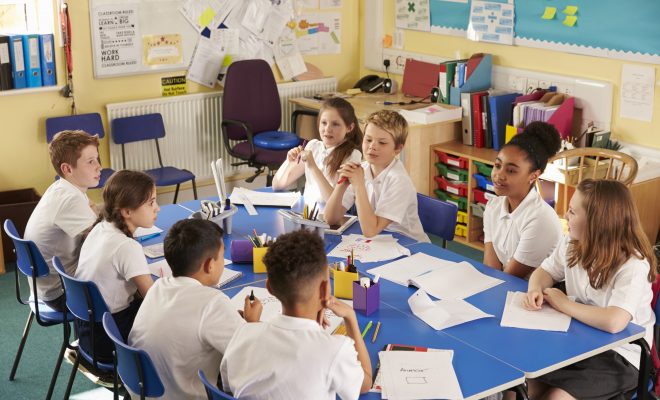What Is Student-Centered Learning and Why Is It Important?

SplashLearn blog – has a wide variety of information, thoughts and notes on parenting and teaching resources.
Education has evolved over the years. What was once a teacher-centered classroom is a student-centered learning environment. But what is it? A healthy student-centered learning environment is one where students feel comfortable taking risks, trying new things, and being themselves.
Student-centered learning is an approach to education that focuses on the individual learner’s needs. This type of learning puts the student at the center of the learning process and gives them a voice in what they are learning.
The teacher is more of a facilitator than a lecturer in a student-centered classroom. This learning environment allows students to be more engaged in their education and take ownership of their learning.
Tips for Creating a Healthy Student-Centered Learning Environment
Now that we know what a healthy student-centered learning environment looks like, let’s discuss some tips for creating one.
- Create a Positive and Supportive Classroom
The first step to creating a healthy student-centered learning environment is establishing a positive and supportive classroom. This means building a safe and welcoming space for all students. It is essential that each student feels like they belong in the classroom and that their voice is heard.
- Encourage Student Choice and Voice
It is essential to encourage student choice and voice in a student-centered classroom. This means giving students a say in what they are learning and how they are learning it. When students have a voice in their education, they are more likely to be engaged and motivated.
- Promote Student-Led Learning
It is essential for students to feel like they have some ownership over their education. When students are involved in the learning process and feel like they have a say, they are more likely to be engaged. One way to promote student-led learning is to give students choices. For example, you might ask them to choose the topic of their next project or which book they want to read for class.
- Encourage Risk-Taking
In a healthy student-centered learning environment, students feel comfortable taking risks. With this type of environment, students know that they can make mistakes without being ridiculed or punished. This healthy risk-taking will lead to more innovative thinking and problem-solving.
- Allow for Flexibility
Flexibility is critical in a student-centered classroom. Let your students dictate the pace and direction of the lesson. This means being open to changes in lesson plans and willing to improvise when necessary. There will be times when you need to take control, but try to give students freedom.
- Respect Each Student’s Uniqueness
A healthy student-centered learning environment is one where each student feels respected. The teacher understands that every child is different and has unique needs. This means that the teacher adapts their teaching methods to meet the needs of each student.
- Encourage Cooperation, Not Competition
With student-centered learning, the focus is on cooperation, not competition. In a healthy learning environment, students work together to support and help each other. This type of environment fosters a sense of community and belonging.
What Are the Benefits of Student-Centered Learning?
There are many benefits of student-centered learning. When students are actively involved in their education, they are more likely to retain the information. Here are some other benefits of this type of learning:
Increased Engagement
When students are at the center of the learning process, they are more likely to be engaged. This is because they are more likely to be interested in the material when actively involved in the learning process.
Improved Critical Thinking Skills
With student-centered learning, students are constantly engaged in active problem-solving. They are encouraged to ask questions and think critically about the information they learn. As a result, they develop strong critical thinking skills that they can apply in all areas of their lives.
Strong Relationship With the Teacher
The teacher takes on more of a facilitator role in a student-centered classroom. This allows them to get to know their students better and build stronger relationships. When students feel comfortable with their teacher, they’re more likely to take risks and ask questions.
Develops a Love of Learning
Learning should be fun! When students are actively involved in their education, they’re more likely to develop a love of learning. When students enjoy learning, they’re more likely to continue learning throughout their lives.
Better Preparation for the Real World
Students will be expected to solve problems and think critically in the real world. Student-centered learning provides students with the skills they need to succeed in the real world.
What’s the Difference Between a Student-Centered and Teacher-Centered Classroom?
In teacher-centered learning – also called didactic, direct instruction, or expository teaching – the focus is on the teacher. The teacher plans and executes lessons, manages the classroom, and assesses student understanding.
Students are actively engaged in the learning process in student-centered learning – also called discovery learning, inquiry-based learning, or learner-centered instruction. They collaborate with their peers, use technology to access information, and take responsibility for their education.
So, what’s the difference between these two approaches? Let’s take a closer look.
In a student-centered classroom, the teacher’s role is to facilitate learning rather than deliver information. This means that students are actively engaged in the learning process, and they are encouraged to think critically, solve problems, and draw conclusions.
On the other hand, the teacher is the expert in a teacher-centered classroom, and the students are the passive recipients of the information. This traditional approach to teaching has been the norm for centuries, but the student-centered approach is now challenging it.
While the teacher-centered approach is still used in many classrooms, the student-centered approach is gaining popularity. It is more effective in promoting deep understanding and long-term retention of information.
How Do I Implement Student-Centered Learning in My Classroom?
Therefore, if you want to implement a healthy student-centered learning environment, here is what you need to do:
Gradual Release of Responsibility: You can’t just put students in charge of their learning and expect them to know what to do. Instead, you need to release responsibility to them gradually. Start by modeling what you want them to do, then have them practice with your guidance, and let them work independently.
Flexible Grouping: Student-centered classrooms are flexible, which means that students can be grouped in various ways depending on the task at hand. For example, students might work in pairs to complete a task or be grouped according to ability level.
Use Technology: Technology is a great way to facilitate student-centered learning. Students can use it to access information, communicate with their peers, and submit their work. You can use online learning games eg. offered by SplashLearn in your classroom to make learning fun and engaging for your students.
Encourage Students to be Self-Directed: Students are encouraged to be self-directed learners in a student-centered classroom. This means that they take responsibility for their learning, set their own goals, and assess their progress.
Project-Based Learning: Project-based learning is a great way to promote student-centered learning. In this type of learning, students work on long-term projects relevant to their lives and their world.
Let’s Make Your Classroom More Student-Centered!
Creating a healthy student-centered learning environment is not only suitable for the students, but it’s also great for the teachers. When teachers can take a step back and let the students take control of their learning, it allows for a more hands-on approach that can benefit all parties involved. We hope that these tips will help you create a more student-centered classroom!
Frequently Asked Questions (FAQs)
- What are the characteristics of student-centered learning?
There are several characteristics of student-centered learning, but some of the most important ones include putting the students at the center of the learning process, basing instruction on students’ needs and interests, and using various instructional strategies.
- What are some examples of student-centered activities?
There are many different types of student-centered activities, but some examples include project-based learning, problem-based learning, and inquiry-based learning. Learning games and simulations are also often used in student-centered classrooms.
- Why is the theory of student-centered learning gaining popularity?
The theory of student-centered learning is gaining popularity because students are more likely to be engaged and motivated when actively involved in their education. Second, student-centered instruction is often more effective than traditional, teacher-centered instruction. Finally, technology in classrooms has made it easier for teachers to implement student-centered activities.
- Which types of learners benefit most from student-centered instruction?
All types of learners can benefit from student-centered instruction, but some research has shown that kinesthetic and visual learners tend to benefit the most.
- Are there any drawbacks to student-centered learning?
One potential drawback to student-centered learning is that it can be challenging to implement in large classrooms. Another potential liability is that some students may need more guidance and structure than what is provided in a student-centered learning environment.
SplashLearn is a game-based, digital learning program and covers Pre-Kindergarten through Grade 5 for math and reading. Trusted by over 750K teachers worldwide, SplashLearn makes lesson plans more interactive!
Teachers and schools can access SplashLearn for free here.










